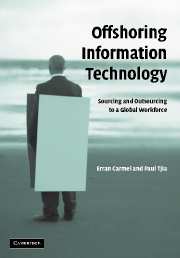Book contents
- Frontmatter
- Contents
- List of contributors
- Foreword
- Preface
- Acknowledgments
- Part I The fundamentals
- 1 The offshore landscape
- 2 Offshore economics and offshore risks
- 3 Beginning the offshore journey
- 4 The offshore country menu
- Part II Managerial competency
- Part III Other stakeholders
- References
- End notes
- Index
4 - The offshore country menu
from Part I - The fundamentals
Published online by Cambridge University Press: 11 August 2009
- Frontmatter
- Contents
- List of contributors
- Foreword
- Preface
- Acknowledgments
- Part I The fundamentals
- 1 The offshore landscape
- 2 Offshore economics and offshore risks
- 3 Beginning the offshore journey
- 4 The offshore country menu
- Part II Managerial competency
- Part III Other stakeholders
- References
- End notes
- Index
Summary
Close to 100 nations are now exporting software services and products. The “offshore menu” is immense, with many nations to satisfy any taste. These nations span the economic spectrum from newly industrialized economies, through transition economies, to developing economies, and even some least-developed nations.
The 1990s was the first decade of software's true globalization. The 1990s saw the rise of three celebrated success cases, the “three ‘I's” – India, Ireland, and Israel. These were the three nations that seemed to appear overnight as global centers of important software activities. One of the most interesting features of the “three ‘I's” is that each of these three nations developed and specialized in different aspects of software. That is, each one progressed to become a global software player in different ways: India in offshore programming, Israel as an incubator of software products, and Ireland in programming services and localization services.
Three tiers of software exporting countries
The G7 nations produced much of the world's software in the first few decades of the computer era. High-tech exporting used to “belong” to these nations with the USA as the hegemonic power in software. Until roughly 1990, very few nations exported software products or software services at any non-trivial levels, including that which today we call “outsourcing”. The G7 nations are still at the core of the Tier-1 software nations (see Table 4.1), the Mature Software Exporting Nations. These G7 nations have a tradition of exporting high-technology and knowledge-intensive products and services.
- Type
- Chapter
- Information
- Offshoring Information TechnologySourcing and Outsourcing to a Global Workforce, pp. 69 - 90Publisher: Cambridge University PressPrint publication year: 2005



